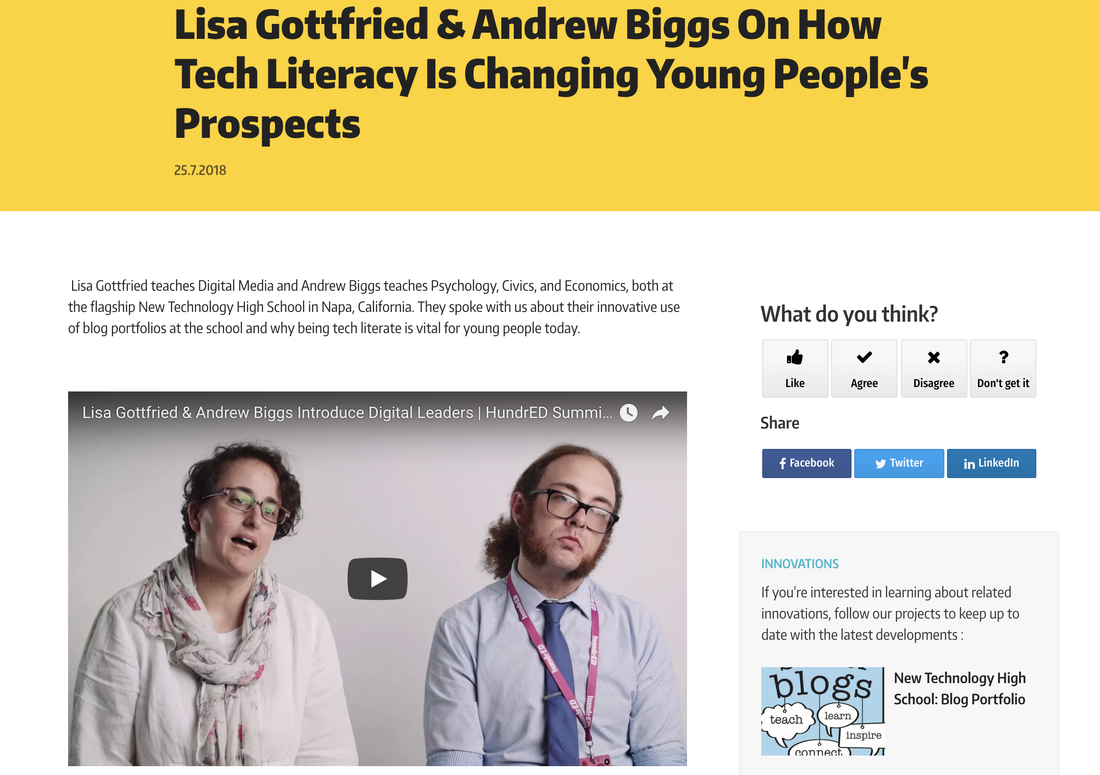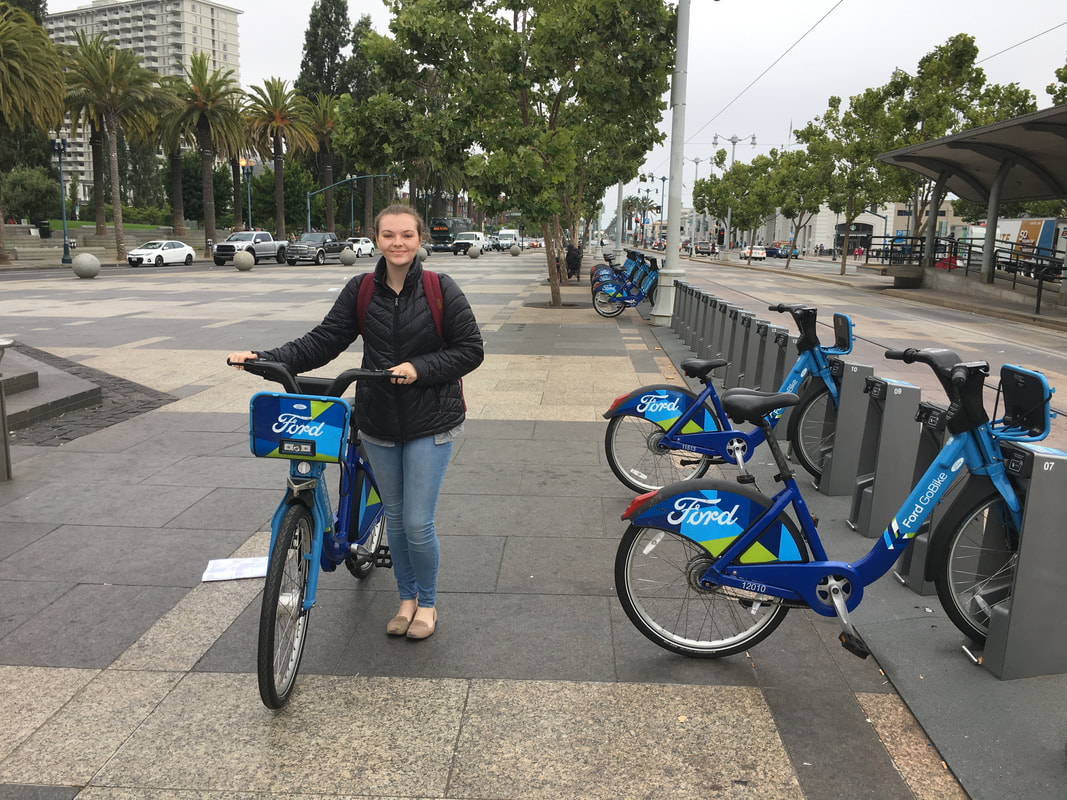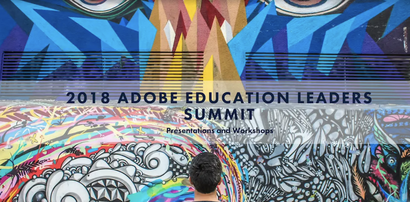|
Welcome to my Lantern building project here at New Tech High. I'm excited to share some information about how I built my 9th grade lantern prototype here on my blog post. We are creating lanterns for the Napa Lighted Art Festival. Below you will see photos of my geometry rationales that prove to you that the shapes I am using are Regular Polygons. How to Create Regular Polygons1) First get a compass and a straight edge 2) Draw 2 circles 3) Label on X and the other Y Rationale or ProofHere's the explanation to why the regular polygon appears the way it does. For example, I made two circles with equal radii so each side of the triangle is equal to the radius.
0 Comments
We often make the mistake, as educators, of going to community and industry partners with our hands out. We ask, "What can industry do for my students? How can industry help" It wasn't until I was talking with a team member at an Adobe field trip that I realized that I tend to swap that request around. My first question, whenever I meet anyone in industry is, "How can my students help you with your business?" It was in the asking of that question, with a team of people from Adobe who happened to be touring my school, that I began what has been a powerful relationship with their company. It turns out that Adobe often wants the feedback of students on product that is in development. They want students who can speak up, are not afraid to offer clear opinions, that are interested in making beautiful images with their products, that understand the basics of project management, and who are generally mature enough to work with a team of adults to communicate clearly what they want and don't want.  To that end, a group of my students were invited to come visit Adobe Headquarters this week, to work with a team of researchers and developers on product. Students got to show the team how they use the product, discuss what they like and don't like, review marketing preferences, and answer a whole host of questions. To some students, it would be intimidating to meet with 15 adults and to be put on the hot seat, but because we concentrate on building collaboration, and oral and written communication skills at New Tech High, these students were up to the task. After having a great working session with the crew and speaking with their research folks, we has an incredibly powerful career panel, where a small team of people with varied job titles at Adobe, spoke to the students about their path from high school to Adobe. They talked about their trials and tribulations, as well as where they chose to pivot to pursue their interests instead of staying on whatever path they thought they were supposed to pursue. The general message was one of supporting students to think about following their bliss, considering design your own majors or double majoring in seemingly disparate subjects, or choosing minors that support their creative passions. The entire trips was eye opening for all the students. They were super grateful to have the time and the special connections they made with folks at Adobe. Surprisingly, the Adobe folks were also super grateful to have the students there. I think that in making industry partners, the relationship has to go both ways. We can not just take, take, take, but also offer added value to our partners, such that we help companies in some way, by offering insight into a demographic they don't normally hear from, or by creating great product that can help companies in their endeavors. What an incredible day. I know it has helped my students gain confidence, gain more clarity about what their next steps are in college and beyond, and it's opened doors for them that would not normally be open. I hope all teachers are on the lookout for ways to partner with industry. Just remember, ask not what your industry partner can do for you, but what you can do for your industry partner! Externships can give you some of the biggest payoffs in terms of time spent. I KNOW teachers need their vacations to regroup and recharge. However, if you invest a few days or a week of your time during winter or spring break, it can really change the way you bring your game to the classroom and change the support that you get from outside businesses. In the long term, I'll work during a break any time to get that kind of support from outside business! I'm a better teacher and the opportunities it has opened for my students are amazing. Read on to find out why it's worth it.... A crew from Adobe walked through my classroom last year, wanting to see what we were up to in Digital Media. I had just read an article about externships, where teachers work at a business for a period of time to get outside of the classroom bubble, and happened to ask one of the visitors if Adobe ever did anything like externships. The response was, "Not that I know of, but if you do some research and get back to me on it, we can keep exploring that idea." Fast forward a year and I've had the privilege of externing twice as Adobe, once during Spring Break for a week and then for another week and half this summer. Needless to say, it was a huge success and one which I can't speak highly enough. Bottom line, both teachers and students can benefit greatly from teacher externships. So what was it all about and why should you explore your own externship possibilities? Externships are defined as a set amount of time that teachers work at a company, usually a few days to a week or two. On-site tasks for teachers can include attending meetings, shadowing a variety of jobs, doing research, providing support that college-aged interns might provide, and just being a useful employee. Externships can be paid or unpaid, depending upon the business, the district or the pre-created externship program. I was lucky enough to get some grant money as a stipend for my first externship and was then invited back by Adobe on their dime for a second externship a few months later. For both externships, I was embedded on a product development team, worked on providing valuable insights into the education community, what teachers and students need, gave feedback on product iteration, had conferences with heads of various product teams to talk about what is most important for students, met with people whose focus was on forward-thinking educators, met with designers, coders, marketing people and more. I observed what types of physical environments in the workplace support creativity, problem solving and productivity, learned about how teams collaborate in the real world, learned what tools people use to communicate remotely and in person, and was steeped in project management approaches in the professional world. And because I was embedded at a company that uses the very skills that I teach my digital design classroom, I got a chance to connect and geek out over digital design concepts, such as font choices, color choices, use of hierarchy, and design thinking as it is applied to product creation. I saw, in action, how to conduct user interviews, user testing sessions, conduct my own research and create user profiles and more. I helped my team better understand the very students, teachers, creative professionals and business folks they are developing product for. It was beneficial for both me and for Adobe. I got to see how the sausage is made and they got unique insights into what really happens in a digital media classroom. How my experience changed what and how I teachThe amazing things is that I have now brought best practices back to my students in all areas of learning, including how to best collaborate on projects, how to use more elevated and practical knowledge of design principles and how to best manage workflow. I can speak with confidence to my students about why certain things that I teach are important and where they come into play in the day to day operations of a tech company. I have a much clearer idea of what sorts of jobs are available to them once they leave school and how to direct them toward those opportunities. Once you are in the door, the possibilities are endlessThere were all sorts of outcomes that were completely unexpected that came out of being in the Adobe office.
NONE OF THE ABOVE THINGS WOULD HAVE HAPPENED WITHOUT PHYSICALLY BEING AT THE COMPANY. If you want to make things happen for your school and open up opportunities for your students, you have to show up and get some face time with the business people who can make that happen. The truth is, businesses are wanting to help us in the classroom and with our students. But in order to forge those relationships, you have to go where the businesses are, and not the other way around. That means getting out of your classroom, pushing yourself to make some calls to businesses that align with what you are doing in your classroom and asking for connection and help. And even without all these amazing connections that I've made, if I did nothing else, I've learned about how business operates, how adults use the skills I teach every day, and how students can plug into that adult world, once they enter the workforce. That, in and of itself, makes the externship experience worth while. (The secret truth about externships)I was worried that I would be exhausted after giving up my vacation time to work outside of the classroom. It turns out it was surprisingly energizing. It's not like working at school with students. I worked with adults, had real hour long lunch breaks, had time to think and complete my thoughts without interruption, and generally marveled at how adults outside of the education field work every day. It's all very civilized.
If you have any questions about externships, just comment below and I'll be happy to answer them! |
AuthorLisa Gottfried is a CTE teacher with 20 years experience as CEO of her own Video and Motion Graphics Production house. She currently teaches Digital Design at New Technology High School and at Touro University in the Masters of Innovative Learning program. She loves her job and her students! Archives
January 2024
Categories
All
|



















 RSS Feed
RSS Feed
